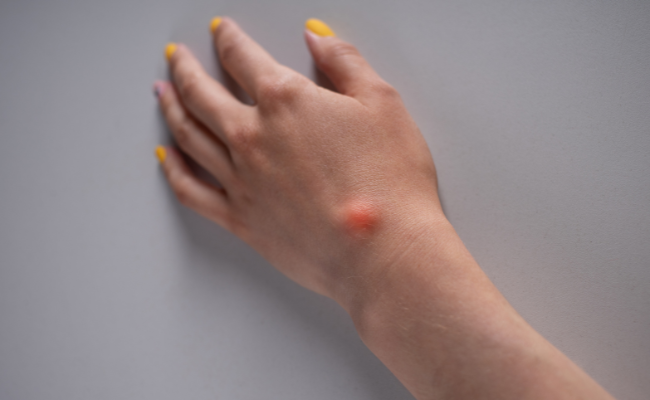How to Treat Ganglion Cyst?
- February 13, 2024
- No Comments

What is a Ganglion Cyst?
A ganglion cyst, also known as a bible cyst, is a small, fluid-filled lump that develops just beneath the skin. These cysts typically form when there's a tear in the tissue covering a tendon or joint, causing the tissue to protrude and form a sac. Ganglion cysts often manifest near specific joints, and moving the affected joint may exacerbate swelling and discomfort. Despite this, ganglion cysts are benign growths and are generally harmless.
Why Do Ganglion Cysts Form?
The exact cause of ganglion cysts is not fully understood. However, they often develop in areas where there is joint or tendon irritation or trauma. Repetitive movements or overuse of a joint may contribute to their formation. For example, activities such as typing, playing musical instruments, or sports that involve repetitive wrist movements may increase the risk of developing a ganglion cyst. Additionally, individuals who have sustained an injury to a joint or tendon may be more prone to developing these cysts. Some theories suggest that joint or tendon irritation leads to the accumulation of synovial fluid, which then forms the cyst. It's also worth noting that women are more likely to develop ganglion cysts than men.
How to Identify Ganglion Cysts?
Ganglion cysts are usually easy to identify due to their characteristic appearance. They typically appear as small, round bumps under the skin, often near a joint or tendon. These cysts may be soft or firm to the touch and may vary in size. In some cases, they may cause pain or discomfort, especially if they press on a nerve or interfere with joint movement. Ganglion cysts may also change in size over time, becoming larger or smaller depending on factors such as activity level or inflammation.
Treatment Solutions for Ganglion Cysts
- Observation: In some cases, ganglion cysts may not require treatment, especially if they are not causing any symptoms. Doctors may recommend simply monitoring the cyst over time to see if it changes in size or causes any discomfort. If the cyst does not grow or cause symptoms, no further treatment may be necessary.
- Immobilization: For cysts that are causing pain or discomfort, immobilizing the affected joint with a splint or brace may help alleviate symptoms. Immobilization can reduce irritation and pressure on the cyst, allowing it to shrink over time. Resting the affected joint and avoiding activities that exacerbate symptoms may also be beneficial.
- Aspiration: Aspiration involves draining the fluid from the cyst using a needle and syringe. This procedure is typically performed in a doctor's office under local anesthesia. By removing the fluid from the cyst, aspiration can help relieve pain and reduce the size of the cyst. However, ganglion cysts may recur after aspiration, especially if the underlying cause is not addressed.
- Corticosteroid Injections: Corticosteroid injections may be recommended to reduce inflammation and alleviate pain associated with ganglion cysts. These injections are administered directly into the cyst and can provide relief for several months in some cases. Corticosteroids work by suppressing the immune response and reducing inflammation, which can help shrink the cyst and alleviate symptoms. However, like aspiration, corticosteroid injections may not prevent the cyst from returning.
- Surgical Removal: If conservative treatments fail to relieve symptoms or if the cyst recurs frequently, surgical removal may be considered. During the procedure, the cyst and its connecting stalk are removed surgically. This is usually performed under local anesthesia on an outpatient basis. Surgical removal of a ganglion cyst is generally considered to be effective in preventing recurrence, though there is a small risk of complications such as infection or nerve damage.
Benefits of Treating Ganglion Cysts
- Pain Relief: One of the primary benefits of treating ganglion cysts is pain relief. Ganglion cysts can cause discomfort or pain, especially if they press on a nerve or interfere with joint movement. By reducing the size of the cyst or removing it entirely, treatment can help alleviate pain and improve overall quality of life for affected individuals.
- Improved Joint Function: Ganglion cysts can sometimes interfere with joint movement, making it difficult to perform daily activities. By reducing inflammation and pressure on the joint, treatment can improve joint function and range of motion, allowing individuals to perform tasks more comfortably.
- Prevention of Complications: In some cases, untreated ganglion cysts may cause complications such as nerve compression or restricted joint movement. By addressing the cyst early and preventing it from growing or causing further damage, treatment can help prevent these complications from occurring.
- Cosmetic Improvement: In addition to relieving symptoms and improving joint function, surgical removal of a ganglion cyst can also improve the cosmetic appearance of the affected area. Ganglion cysts can sometimes be unsightly, particularly if they are large or located in a prominent location. Surgical removal can help restore a more normal appearance to the affected area, improving self-confidence and body image.
Comments (0)